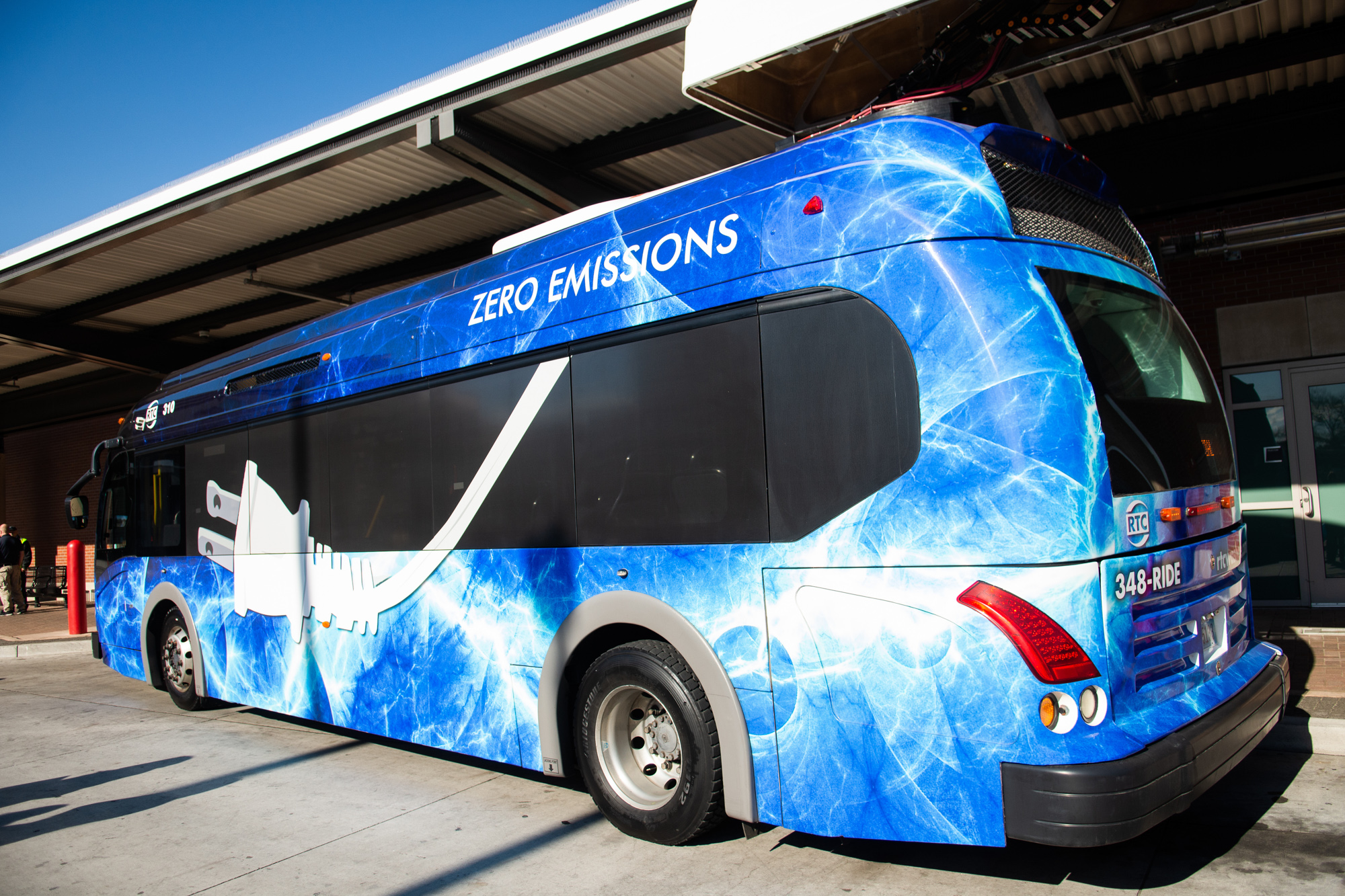Overshadowed by electrification push, hydrogen gains steam in Nevada public transportation

Lithium exploration, geothermal development and expanding transmission capacity are key topics in the drive for green energy development in Nevada. But regional transportation commissions throughout the state are looking to another form of green energy to reduce their carbon footprint: hydrogen.
The Regional Transportation Commission of Southern Nevada added two hydrogen fuel cell electric buses to its fleet earlier this year, the first of their kind to operate in the state. Its regional counterpart in Washoe County is rolling out its first two hydrogen fuel cell buses in early 2024, with six more expected to come online later in the year.
The buses are fueled by compressed hydrogen gas. The fuel cells in the buses combine hydrogen — the most abundant element in the universe — and oxygen to generate electricity, producing water and heat as byproducts.
All 68 of Washoe County Regional Transportation Commissions buses are powered by alternative fuel.
Southern Nevada RTC’s 400-bus fleet consists of 80 percent “clean” buses, mostly powered by natural gas. According to the Environmental Protection Agency, natural gas produces substantially less emissions than coal and fossil fuel.
Less than 2 percent of its fleet consists of zero-emission buses, according to Roger Johnson, manager of zero-emission RTC fleet technology, although the agency is adding 22 hydrogen fuel cell buses in 2024 to join the two it just rolled out.
“It will be a bit of a slow transition, but it’s on our road map to continue pursuing zero-emission technology,” Johnson said. “There’s a lot of advantages hydrogen has to offer.”
According to scientists, embracing hydrogen-powered buses could lead to a slight reduction in Nevada’ transportation-related carbon emissions, which make up the state’s largest source of carbon emissions and are expected to continue increasing in the coming decades.
“Even small changes, as long as everyone is making them, can make a significant impact. Replacing a few buses, then a few more, then a few more, that’s the kind of thing that certainly could have a snowball effect,” said Simon Jowitt, director of UNR’s Ralph J. Roberts Center for Research in Economic Geology. “If RTC says ‘Let’s change all our buses to hydrogen buses,’ then you’ll have other cities saying ‘OK, Vegas is doing it, why aren’t we doing it?’ If we don’t make a change, nothing ever happens.”

Lack of infrastructure has limited hydrogen
The idea of using hydrogen as an alternative fuel gained popularity in the early 2000s, then waned without commercial backing, said Rick Hurt, a research engineer at UNLV who helped draft a failed bid by Nevada and Arizona for federal funding to create a “hydrogen hub” within the two states. Hydrogen is again garnering interest from the federal government, and this time has commercial financing to back it.
“When you can generate [hydrogen] with renewable energy and store it with renewable energy, it’s absolutely a win,” Hurt said.
But it’s challenging to develop the infrastructure needed to transition to a more hydrogen-friendly transportation system.
Only about 1,600 miles of hydrogen delivery pipeline exist in the U.S., primarily in California, Illinois and along the Gulf Coast. Three states — California, Louisiana and Texas — are the major producers of hydrogen; most of what is produced is used for refining petroleum, processing food, producing fertilizer and treating metal. There are only a handful of hydrogen fueling stations in the United States, all located in California.
In 2022, Air Liquide opened a hydrogen production facility in North Las Vegas, producing about 30 tons of liquid hydrogen per day — enough to power 40,000 fuel cell vehicles.
Hydrogen can also be transported by truck — Washoe County RTC will receive weekly shipments from Sacramento and Southern Nevada RTC receives regular shipments from a Southern California-based company. Johnson said the numbers didn’t pencil out to purchase hydrogen locally from Air Liquide.
Earlier this year, President Joe Biden announced that seven geographical regions will receive billions of dollars in federal funding to create hydrogen hubs across the country. Scientists and engineers from more than 40 organizations in Arizona and Nevada, including Hurt, worked together to apply for a piece of the funding.
Transportation commissions embrace hydrogen buses
Although the proposal submitted by Nevada and Arizona was not selected for federal funding, some Nevada entities including the regional transportation commissions have received other sources of federal funding to pursue hydrogen projects or products.
To date, Southern Nevada RTC has been awarded more than $16 million in federal funding for hydrogen fuel cell buses and associated fueling infrastructure.
In 2021, the Washoe County RTC received a $6.8 million federal grant to purchase two hydrogen fuel cell buses and construct a fueling station. This year, the commission received an additional $8.8 million in federal funds to purchase six more buses and expand its fueling station.
The Washoe RTC first added electric vehicles and retired its last fully diesel bus earlier this year. In addition to the new hydrogen buses, it relies on a mix of electric and diesel electric hybrids — buses that can operate in electric mode 35 percent of the time — with fully electric buses composing about a third of the fleet.
A fully electric fleet doesn’t make sense in Northern Nevada, according to Jim Gee, the Washoe RTC’s director of public transportation and operations. Electric buses can only travel about 100 miles between lengthy charges, limiting their use, he said. The hydrogen fuel cell-powered buses get about 300 miles per tank, he said, and take no more than 10 minutes to fill up. The fleet’s electric buses also need to charge all night.
The limitations on charging and mileage make “less and less sense to be fully electric,” he said. “We think hydrogen is our path forward.”
Upfront costs for hydrogen vehicles have historically been high, as have fuel costs, Gee said. But with more people and businesses interested in hydrogen and hydrogen hubs being built, prices will come down, he added.
“All those things are creating economies of scale, and that’s making it a lot more attractive,” he said.

Nevada’s vehicle emissions predicted to rise
Since 2009, vehicle miles traveled in Nevada are estimated to have risen by nearly 37 percent — an estimated 7.5 billion more miles each year.
The state’s carbon emissions numbers reflect that growth. According to a report prepared by the Nevada Division of Environmental Protection (NDEP) looking at greenhouse gas emissions in the state from 1990 through 2016 and projecting emissions through 2039, emissions from the transportation sector made up 32 percent of statewide emissions as of 2020 — the largest of any one category.
Greenhouse gas emissions peaked in 2005 in Nevada, then declined by almost 25 percent through 2020 amid the closure of the state’s two largest coal-fired power plants, the Mojave and Reid Gardner generating stations. The 2008 recession and the pandemic also contributed to reduced emissions, as people drove less at those times.
Although statewide emissions have dropped since the 2005 high-water mark, transportation emissions continue to creep up. In 2015, transportation surpassed electricity generation to become the state’s largest sector of emissions as the state began to rely on more sources of renewable energy for electricity generation.
In 2019, Democratic then-Gov. Steve Sisolak joined Nevada to the U.S. Climate Alliance, a coalition of more than two dozen governors committed to reducing greenhouse gas emissions in line with the Paris Climate Agreement. That same year, Nevada lawmakers passed a flurry of climate-focused bills including SB358, which gradually increased the statewide Renewable Portfolio Standard — a minimum requirement of clean energy generation measured through a credit system — to 50 percent by 2030, and SB254, setting statewide greenhouse gas emission reduction targets (including net zero carbon emissions by 2050) for the first time in state history.
Using the state’s 2005 greenhouse gas emissions as a baseline, Nevada has a goal of reducing greenhouse gas emissions by 28 percent by 2025 and 45 percent by 2030. But according to the NDEP report, the state is likely to fall 7 percent short of its 2025 goal and 22 percent short of its 2030 goal. Gasoline emissions are expected to decrease, but a projected increase in diesel, aviation fuel and alternative fuels will offset that, resulting in an overall net increase.
In July, Republican Gov. Joe Lombardo withdrew Nevada from the climate alliance. Lombardo said the goals of the alliance “conflict with Nevada’s energy policy objectives.”
Still, Nevada lawmakers in 2023 passed the Clean Trucks and Buses Incentive Program through AB184, offering vouchers up to $175,000 in federal funds to Nevada businesses converting from medium to heavy duty diesel vehicles to clean trucks or buses.
NDEP and the Nevada Department of Transportation are setting up the program and funds should be accessible by early 2024, said Assemblyman Howard Watts (D-Las Vegas), who sponsored the bill.
